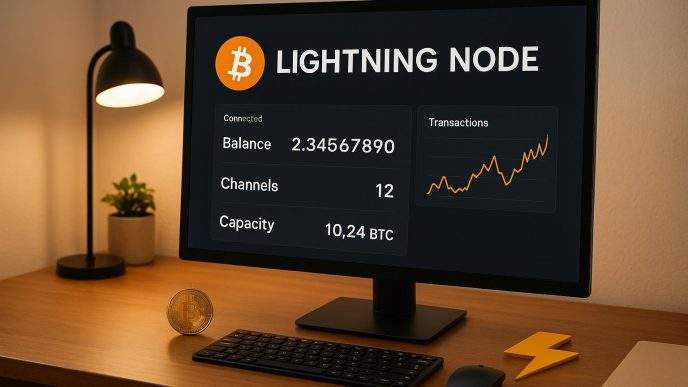As bitcoin adoption continues to increase globally, freelancers and small businesses can now leverage the Lightning Network, a layer-2 solution, to accept fast, low-cost bitcoin payments.
Unlike traditional on-chain Bitcoin transactions, which average 10 minutes and higher fees, Lightning payments settle in seconds with fees as low as $0.001. This comprehensive guide, informed by real-time data, offers small businesses and freelancers the opportunity to tap into the digital economy with confidence.
The Power of the Lightning Network
Since its debut in 2016, the Lightning Network has transformed bitcoin’s scalability, allowing seamless microtransactions for everyday purchases like coffee, freelance services, or retail goods. Its benefits include:
- Ultra-Low Fees: Transaction fees cost an average of $0.001 valued at 1 satoshi (Sats), far below credit card fees, which stand at around 2 to 3%, or on-chain Bitcoin transactions. Note that opening or closing payment channels may incur additional fees—$0.10-$1—depending on network condition.
- Lightning-Fast Payments: Payments are settled between milliseconds and seconds, compared to 10+ minutes with on-chain Bitcoin.
- Global Accessibility: Accept payments worldwide without the delays or high costs of traditional banking, which sometimes reach 6.38% global remittance fees, according to the World Bank.
- Customer Appeal: Attract tech-savvy users, improving your brand reputation in a digital-first economy.
Lightning Network adoption is fast-growing, with El Salvador’s Chivo wallet allowing millions to use Lightning for daily transactions and Strike’s partnership with NCR bringing Lightning payments to United States retail chains.
The network’s capacity has grown to 3,700 BTC—$448,938,900 at approximately $119,769/BTC, with an estimated 650M users having potential access through platforms like Cash App.
While powerful, Lightning remains in its experimental phase, so it advised for businesses should use it for smaller amounts and store larger sums in secure on-chain wallets.
Step 1: Select a Lightning-Compatible Wallet
To accept bitcoin, choose a wallet that supports the Lightning Network, available in custodial or non-custodial wallets. Top options include:
- Wallet of Satoshi: available for both iOS/Android, custodial. It is user-friendly, has no channel setup, and offers a Lightning Address.
- BitPay: available for both iOS/Android, non-custodial. Supports multiple digital currencies.
- Electrum: available on Desktop/Mobile, non-custodial. It is secure and customizable for technical and advanced users.
- Pay with Flash: available for Android, non-custodial. Designed for businesses with invoicing tools.
- Blink Wallet: available for iOS/Android, custodial.
Step 2: Set Up and Fund Your Wallet
- Download and Install: Download your wallet from its official source to ensure security.
- Create an Account: Follow setup instructions. For non-custodial wallets like Electrum and Flash, safely store the 12-24 word recovery phrase offline to prevent loss of funds.
- Fund Your Wallet: Transfer bitcoin from an exchange or another wallet to your Lightning wallet’s on-chain address, starting with “bc1” or “3.” On-chain funding is required for Lightning’s first funding. Start small with 0.001 BTC, worth between $60 and $70 at current prices, to test the system.
- Set Up Payment Channels (non-custodial only): Open payment channels by selecting a node and allocating funds. This may incur on-chain fees, approximately $0.10 to $1, depending on network congestion. Custodial wallets handle this automatically.
Business Tip: Flash wallet integrates invoicing, simplifying setup for businesses.
Step 3: Create Payment Options
Generate payment methods to receive bitcoin seamlessly:
- Lightning Invoice or QR Code:
- Navigate to your wallet’s “Receive” section.
- Specify the payment amount; for example, $30 for a service.
- Create an invoice (text string) or QR code, which customers can scan for quick, error-free payments.
- Share through email, text, or display in-store, like printed QR codes at a checkout counter.
- Lightning Address (Wallet of Satoshi):
- Receive a reusable address (lightningnews@walletofsatoshi.com) when done setting up.
- Customers send payments directly, perfect for repeat clients.
- Customize for branding within the app.
Step 4: Receive and Verify Payments
- Customer Payment: Clients scan your QR code or enter your Lightning Address/invoice in their wallet.
- Instant Settlement: Payments confirm in seconds, with notifications from wallets notifying receipt.
- Verify Details: Confirm the amount and transaction details before delivering goods or services.
- Channel Management (non-custodial): Ensure sufficient inbound capacity to receive payments. Rebalance or open new channels if needed, which may incur fees. Although custodial wallets handle this automatically.
Note: Lightning’s speed improves customer experience, especially for in-person payments.
Step 5: Secure and Manage Your Funds
- Monitor Liquidity (non-custodial): Regularly check channel capacity to prevent transaction failures, using tools like Electrum.
- Protect Your Wallet: Store non-custodial recovery phrases offline. Use strong passwords for custodial wallets.
- Convert to Fiat (optional): Use exchanges to convert fiat, keeping an eye on tax obligations.
- Stay Informed: Follow updates from wallet providers to leverage network improvements and maintain security.
Advantages and Key Considerations
Advantages:
- Cost Efficiency: Fees are as low as $0.001 lower than credit card and on-chain Bitcoin fees, ideal for small value transactions.
- Speed: Near-instant payments improve checkout speed.
- Bitcoin Audience: Attract a growing user base, as seen with X’s Lightning-based tipping feature.
- Global Reach: Bypass international banking fees and delays.
Considerations:
- Learning Curve: Non-custodial wallets require channel management knowledge.
- Price Volatility: Bitcoin’s value fluctuates; convert to fiat in real-time if needed.
- Experimental Nature: Lightning may face occasional transaction failures or security risks, so use it for smaller amounts.
- Tax Compliance: Track all transactions, as digital currency is taxable in most jurisdictions.
- Adoption Metrics: the adoption of lightning network is fast-growing due to its speed,
Real-World Success Stories
- El Salvador’s Chivo Wallet: Powers fast, nationwide Lightning transactions, serving millions.
- Strike and NCR Partnership: Expands Lightning to United States. retail, allowing merchants to accept bitcoin seamlessly.
- Paxful Merchants: Businesses like Lightning Koffee use Paxful’s QR codes for quick and efficient payments.
Watch El Salvador’s Lightning adoption in action:
For freelancers and small businesses, accepting bitcoin through a Lightning Wallet is a game-changer, offering low-cost, instant payments and access to a global audience.
By selecting a wallet, funding it, generating payment methods, and confirming transactions in seconds, businesses can grow in the digital economy. With fees around $0.001 and adoption increasing in regions like El Salvador and United States retail, Lightning is ideal for microtransactions.
Prioritize security, monitor bitcoin’s volatility, and stay updated on network developments.















